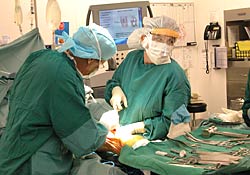Houston site first to use electromagnetic navigation
COURTESY OF DENNY ANGELLE |
An orthopedic surgeon at The Methodist Hospital in Houston was recently the first to perform a total knee replacement surgery using a new electromagnetic navigation system that incorporates minimally invasive techniques.
The electromagnetic technology developed by Zimmer and Medtronic “lays a new foundation for guidance in many areas of surgery, beyond orthopedic surgeries. I would put electromagnetic technology on par with X-rays in what it can do for evolving technologies in the field of medicine,” according to David Lionberger, MD, according to a Methodist Hospital press release.
The new tracking system utilizes technology that replaces infrared cameras now used in many other orthopedic surgical navigation systems. A magnetic field tracks the position of implants and instruments during minimally invasive surgery.
Lionberger likened the information available from an electromagnetic system like the one he is using to a three-dimensional (3-D) radiograph, but without unnecessary radiation exposure for the patient.
The system works via minute changes in electrical current made when the surgeon changes implant or instrument positions. These are calculated by the system computer, which produces a realistic image that the surgeon can view intraoperatively. Due to this process, he considers the overall system to be more accurate than other currently available navigation technologies.
“With incredible accuracy and tiny instrumentations, this system allows us to ‘fit the computer’ into the patient’s body without taking away from minimally invasive incisions,” Lionberger said.
The electronic magnetic fields used by the system safely penetrate bone and soft tissue and are less disruptive to the patient and the surgeon, he said.

